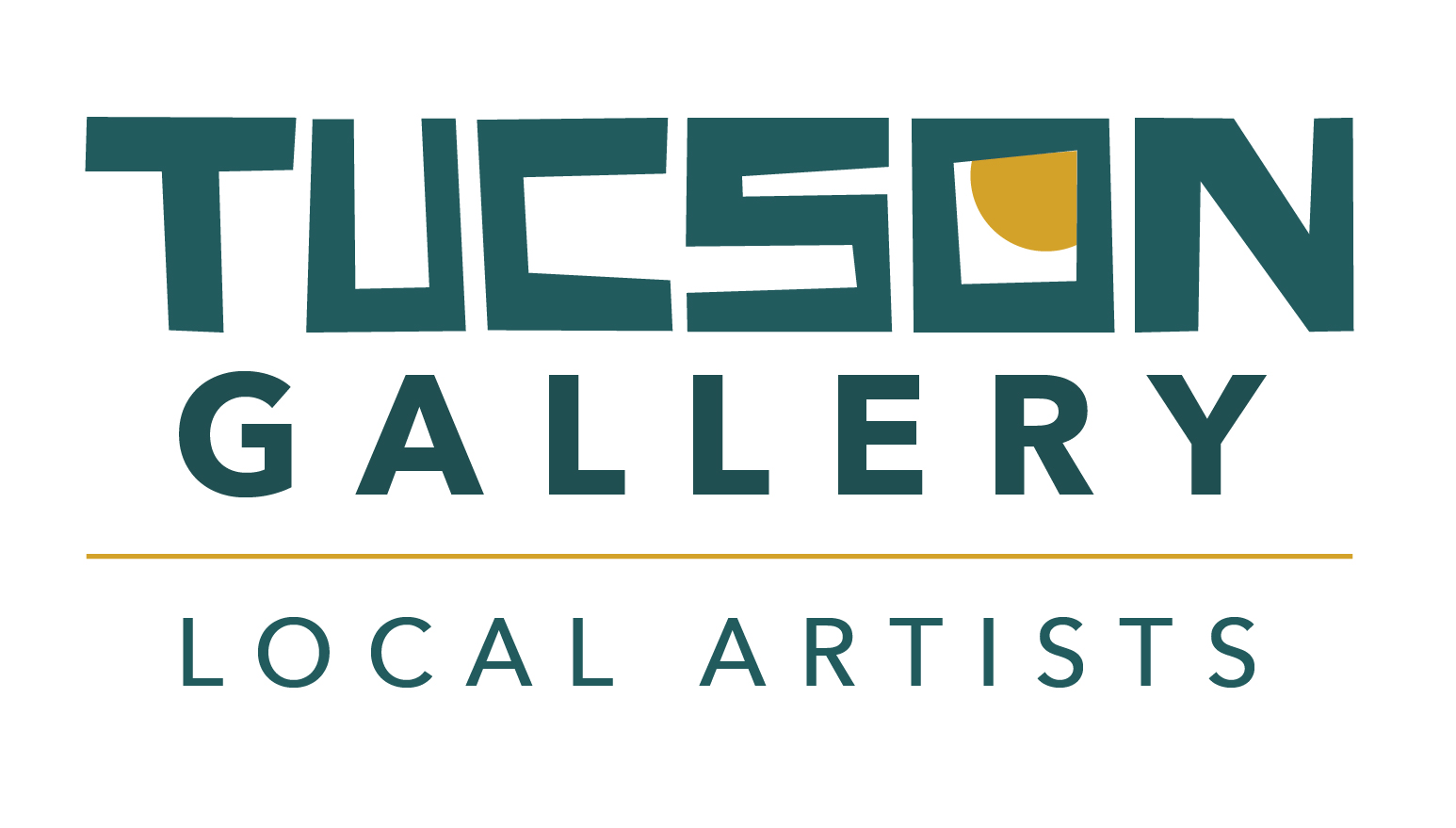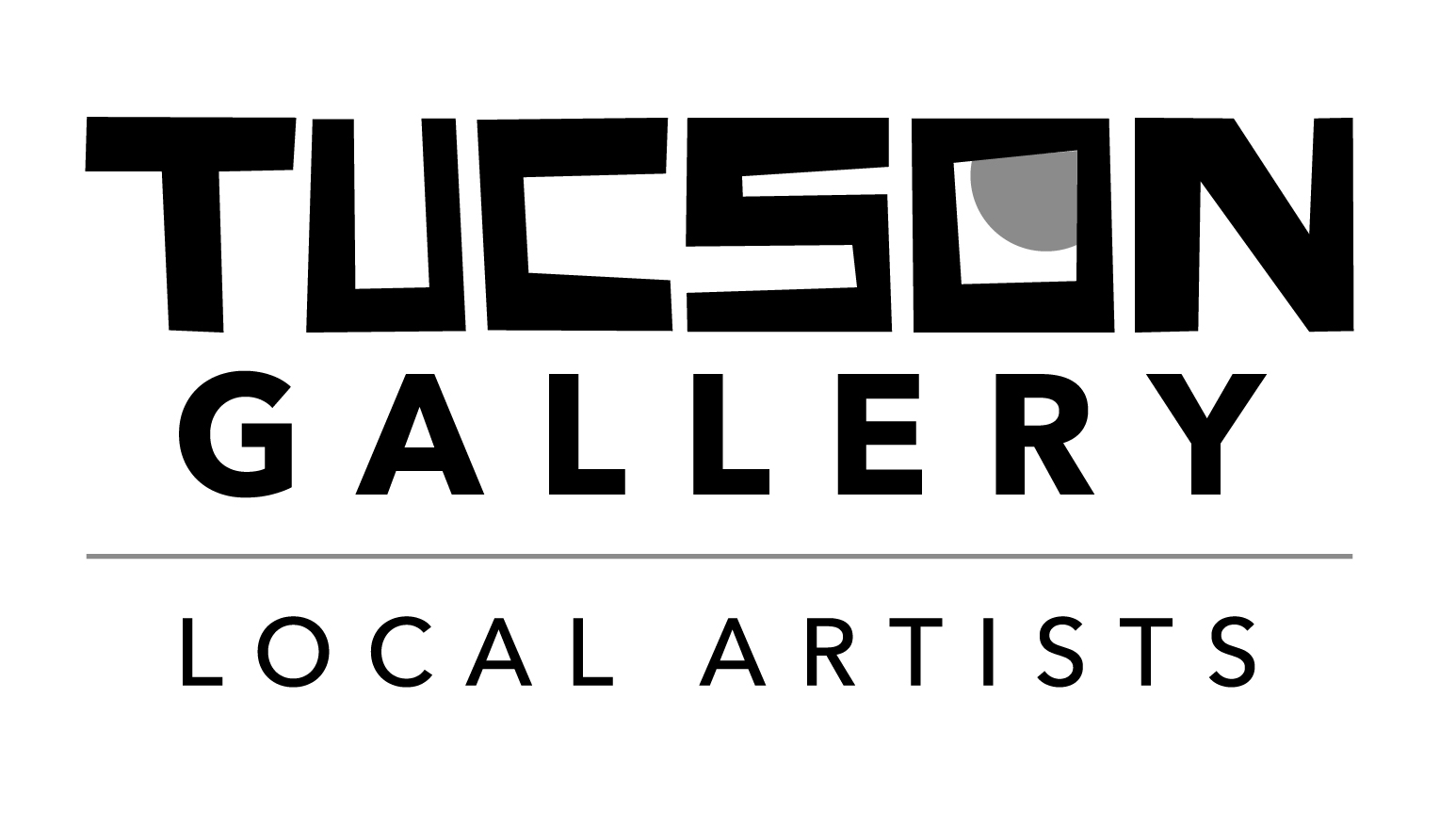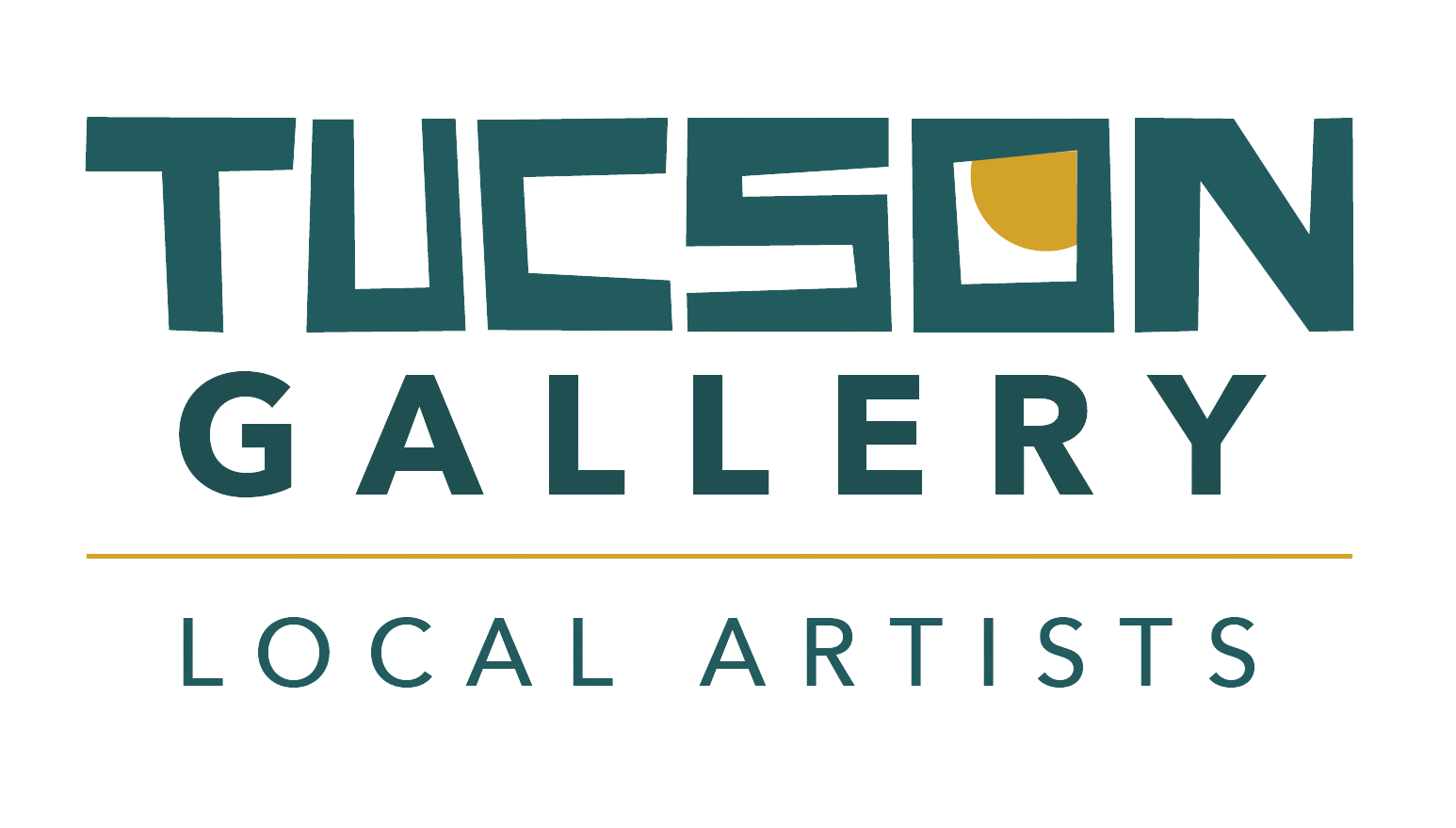Media
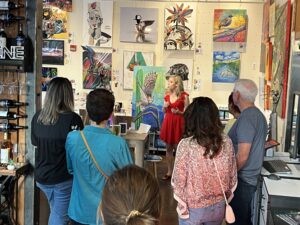
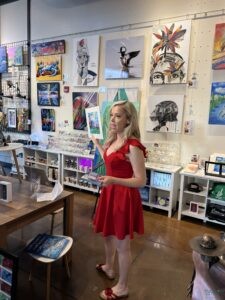
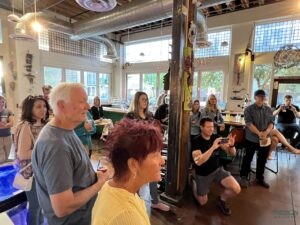
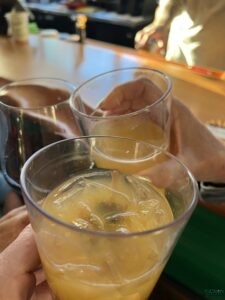
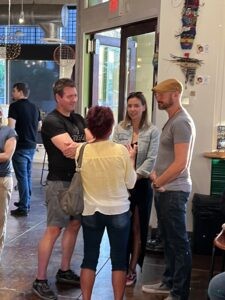
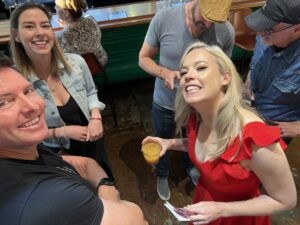
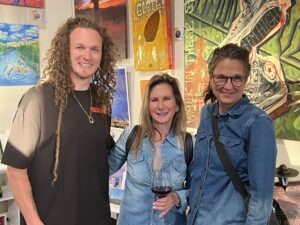

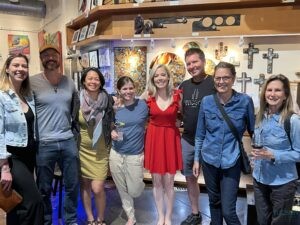
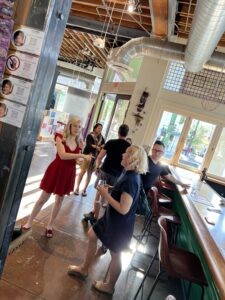
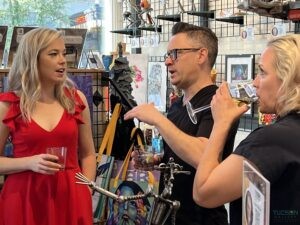
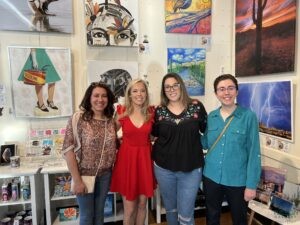
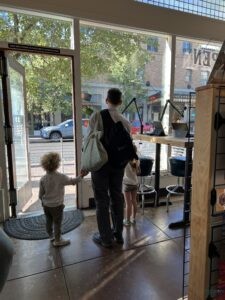
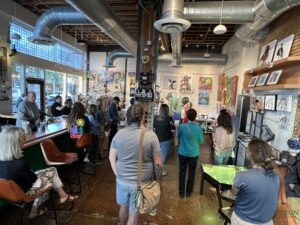
Transcript (Unedited)
Tom Heath
All right, it’s time for another installment of Meet the Artist, a production of the Tucson Gallery. We’re located inside of the proper shops at 300 East Congress Street. Cross the street from Hotel Congress, a couple doors down from Rialto Theater. You cannot miss us. Retail in downtown, all local artists. More information on our website, thetucsongallery.com.com and of course, every week we have a Meet the Artist event where they come live, they chat, they do presentations. Sometimes they just have a drink, but it’s always fun to get them in here and talking. And as part of that, we record a podcast, and that collection is available on our website as well. And today we are joined by I don’t even know how to describe the number of jobs this woman has, but I’m just going to say her name. And then we’ll do her intro because her intro is going to take the entire time. But we have the Julie Bonner with us today.
Julie Bonner
Thank you. Happy to be here. Today is going to be a good day today.
Tom Heath
Tonight, it’s all going to be fun, the whole day. And so we’re recording this and then it gets played back. And I know some of the things you’re doing, they’re probably going to happen before this actually airs, but you got some cool stuff coming up. Like, you’re doing a huge presentation in a week, aren’t you?
Julie Bonner
Yes. For the Public Relations Society of America. It’s pretty epic.
Tom Heath
I think this might be the fanciest guest we’ve had.
Julie Bonner
That Joe Pagac pretty fancy too.
Tom Heath
I don’t know. He dresses like a hot dog. It’s not fancy. I’ve seen more and more of this where you are out doing presentations because let’s set the stage here. You’re an artist. You make wonderful paintings in our gallery. You’ve got a tremendous line of merchandise. You’re a creative director, you’re a consultant, you’re a speaker. You do all of these things, and you help artists make money, and you’re just like everywhere. How do you manage all of this?
Julie Bonner
I think 8 hours of sleep. I think if I don’t sleep 8 hours, then it all falls to pieces. So I’m going to say good sleep.
Tom Heath
Last time I saw you present was at Ten West.
Julie Bonner
Oh, yeah.
Tom Heath
You were doing something there with branding.
Julie Bonner
That was great. That was really fun. Awesome panel about branding.
Tom Heath
And then this event you have coming up with that acronym you just used. This is like a larger convention, though, right?
Julie Bonner
Yeah. It’s the Western District National Conference. And I’m talking about design for communications, which is to me, super exciting. Anytime I could talk about design and art and help educate others about that makes me pumped up.
Tom Heath
All right. And I definitely get that sense. You really have this glow about you when someone gets it and they sort of change how they do things and they understand what you’re saying. You can see you’re like, okay, check that wife saved one person. Now who’s next?
Julie Bonner
I saved one person from Papyrus and Comic Sands.
Tom Heath
And I was the person she saved. Comic Sands, just so you know. So let’s start what happened first? Were you a creative designer or were you an artist first? What came first?
Julie Bonner
Or did they honestly being an artist? So when I was three is when I exclaimed to my teacher parents that I wanted to be an artist. And my dad, who’s a math teacher, was like, what does that mean? I don’t understand. I can’t compute. So I’ve always been an artist and always drawing, painting, and art class was always my favorite in school.
Tom Heath
Okay, so three years. And at what point did you start really sort of looking at art as a ways to make an income?
Julie Bonner
I would say my first paid creative project was I was a senior in high school in New York, and a local pizza place needed a logo.
Tom Heath
Okay.
Julie Bonner
And so I designed a logo and they’re like, hey, can you paint can you paint it on the window? And I said, sure. And then they said, do you know anyone that wants to work in the pizza place? And I was like, yeah, I could use some extra money. So I ended up working there too, and delivering pizzas. So it was like a win win.
Tom Heath
That seems like the typical Julie job. I’m going to do your marketing and graphic design. I’ll do all of your artwork and yeah, I’ll deliver your pizzas too.
Julie Bonner
Yes.
Tom Heath
Fantastic.
Julie Bonner
Delivery was my favorite part. Like driving in my Volvo, playing my rock music. So fun.
Tom Heath
How did you get from New York to Tucson?
Julie Bonner
Oh, jeez. An old relationship. But I stayed because I loved it so much. So this was 20 years ago.
Tom Heath
Wow.
Julie Bonner
So I feel like a Tucsonian at this point.
Tom Heath
I think so I’ve been here a little bit longer than that and I feel like Tucson ish yeah, Tucson ishan.
Julie Bonner
Yeah, maybe I’m Tucson esque.
Tom Heath
There you go. Not quite a native Tucson, but they’re long enough. I think now that there are adults in the world that were born in Tucson that have been here less time than me. I think I count.
Julie Bonner
Yeah. 1% hundred.
Tom Heath
So you started like, freelancing then, and then you got a job doing doing this, like a full time job.
Julie Bonner
Yeah. So I actually decided in high school to study graphic design. And so I went to college at Drexel University to study graphic design and play tennis for Drexel D One. And so four years of education and design, and I got to hone some fine art skills there too, so it was really fun. And then from there got a job as a graphic designer in house over in Philly.
Tom Heath
Okay, nice. And then I know when you moved to Tucson, the first project I saw you working on was the Desert Dwellers Flashcards. Oh, I think that’s the first time I really got to know you. But that was really like a project for your son.
Julie Bonner
Yeah. Desert Dwellers came about when Syver was about one and so I was teaching him the alphabet and using books and I was like, some of these are boring and maybe we can have something that features our local wildlife because I’m a big animal lover. And so came up with the idea to create a set of flashcards of desire animals from A to Z but also combining my passions of painting and education and so that’s where the concept came from.
Tom Heath
How old seaver now?
Julie Bonner
Oh my gosh, seaver is twelve.
Tom Heath
All right, so I’ve known you about eleven years then I think you’re just kind of getting that launch. Maybe you just put that out to the public somewhere after that. So what does A stand for in your desert dwellers?
Julie Bonner
In my set it’s Anna’s Hummingbird all the way to zebra tail lizards.
Tom Heath
So Anna’s Hummingbird is the name of the hummingbird?
Julie Bonner
Yeah.
Tom Heath
I didn’t know that. I gave you a hard time because I’m like, okay, I don’t understand. Okay, this is really cute, but A like you really stretch to get Anna’s Hummingbird. I thought Anna was like a person used to the name in there and you’re like, no, that’s the name of the bird.
Julie Bonner
Oh yeah.
Tom Heath
See I’m learning too. They help adults as well.
Julie Bonner
I actually try to include like fun facts and stories that even as an adult we don’t know, try to make it really fun. And also of course it’s pretty hard to get a whole alphabet. Like X was tricky, but a big goal of mine was getting birds, mammals, reptiles, like arachnids, as diverse as I could in 26.
Tom Heath
And if you haven’t seen these, they’re flashcards with a beautiful drawing on one side and then the alphabet letter and the story on the backside.
Julie Bonner
Yeah.
Tom Heath
And then some of your drawings then I think you’ve actually turned into larger prints and you offer those just as standalones, I think.
Julie Bonner
Yeah. So the original 26, they were acrylic paintings I actually showed in the Madeiris Gallery years ago. Wow, you are fancy. But look at this. Now I’m in the Tucson Gallery. So this is exciting. And then took that and that’s some of the things I promote is like how can you use your art and create other products and art gifts from that? And I credit also. Diana moderis was a mentor of mine and she is amazing at business and understanding how to sort of work the wholesale retail scene and how to expand and so I’ve learned a lot from her and continued to make prints and greeting cards and posters of my art.
Tom Heath
Yeah. Your philosophy is very much what we were striving for when we had the gallery is how to continue to make money after you’ve created the original work. And there was no question Tony, Ray, Darryl, my business partners in this, we were all immediately like, yeah, we need Julie involved from the beginning to really kind of help bridge that gap. Because your mind works differently than a lot of others, because you have the creative side, but you also have that analytical business side that must be come from your dad and the math, maybe, but you bridge both gaps. We see people that are heavily on one side or the other and they struggle.
Julie Bonner
Yeah, it can be hard. So one thing was years ago, I was thinking that I wanted to start my own art business. So for ten years I actually ran my own graphic design business. But right before I decided to go back to school and I earned my master’s in business. And that was to help just make me feel more comfortable, just sort of understanding the business side of things more. And so I love doing that, doing both of those sides. But to artists, those don’t normally come naturally and so it can feel really weird to promote yourself, to market yourself, to put yourself out there. But I think we’re creating here at the Tucson Gallery like a really nice collective and supporting artists, helping artists.
Tom Heath
And it’s interesting because we’ve been doing these meet the artists for a while and the artists approach the promotion of their event a little bit differently. But again, no one’s done it like you where you made them create your own drink. You’re out here creating events, you’ve got talking points and everyone else just shows up and they’re going to have like a glass of beer or something. And you’re ready, you’re like, bring it on. I’m going to use this opportunity to teach people.
Julie Bonner
Yeah. No, I’m excited tonight. I hope to help up and coming artists, give them some tips about how to connect, maybe how to promote themselves, and some other things that maybe you don’t think of right away. But they’re really not that hard. As long as you just start small, it’s not too much.
Tom Heath
Yeah. Because this is airing after the meet the artist fence. Some people may have missed it. What are a couple of those tips? What are some of those things that you might want to impart to this younger generation, or not even younger generation? This newer artist getting into the field.
Julie Bonner
Yeah. Anyone that’s creative and has been thinking about, like they’re a maker, painter, designer, photographer. One of the things that I talked about earlier was sort of combining my passion so with the flashcards. It really was a passion project. So art, animals, education, helping my son, so it was everything wrapped in one. And then when you design something or create something that really speaks to you, you do it with so much heart and so much you create a really quality product and then what happens from there is other people see that and you get hired to do more of the same. And I know that Joe had done that with his mural on stone. He created something that was his concept, not a client concept, and it helped show the general public, like, hey, I can do this. Prior to that, most people knew me as a graphic designer, and I was known for logo and identity design, but not necessarily fine art. So it was my way with the flashcards, was showing people I’m a fine artist too.
Tom Heath
Yeah. I think the authenticity that comes through really creates a really solid product, both artistically and commercially. And you mentioned earlier with Diana Madeiris, you found a mentor in that. A lot of these artists, they talk about someone in their life that gave them that spark or that courage. How do you find a mentor?
Julie Bonner
What’s funny is I admired her work and her business sense, and so I actually went to the gallery, and I know she was hiring for sales positions, and so I just went in, and I was like, okay, maybe I’ll be a salesperson here. And so we got talking, and I wasn’t the best, but it got us sort of chatting, and so it worked out where I got her advice about sort of wholesale and creating my art and some feedback on some of my paintings, and then I helped her with some graphic design and some event promotion. And so I really figured out how it could be a win win for both of us. So I learned a lot. So I think if you just kind of put yourself out there, I’m not necessarily a salesperson, but I went in, I was like, okay, I’d like to connect with her. What can I do? How can I help? And so that’s one way I think people can approach someone else to possibly learn something from. Maybe there’s something you can help them with too.
Tom Heath
Yeah, I think that’s a really good point. Some of the conversations we’ve had in the past, the conversation is why I was lucky to find or I was fortunate to be in this situation. But even though they consider themselves lucky, the artist put themselves in that situation, it was intentional, and they ended up attracting what they needed. They might not have known right away, hey, I’m going to have Dinah Madearis as a mentor, but you knew going in, I want a little bit of what she’s got. I’m willing to give something and hopefully get something as well.
Julie Bonner
Yeah, really. I mean, I’d say go for it, and the worst you hear is no, and it’s okay.
Tom Heath
Yeah, sometimes hard to hear that, but trust me, you hear it long enough and you get used to it.
Julie Bonner
You do enough art markets, and you can get used to every kind of thing.
Tom Heath
So let’s talk about some other things that you are doing, because I know this is not art related, but it’s kind of like a tangent because you just recently with your husband, Jeff, who’s got products here in the gallery. You purchased a home as an airbnb, and then you went in and arted it up. You got all kinds of like you went crazy on that house.
Julie Bonner
This was really exciting. So we turned the home that we were living into airbnb, and decided on a theme. So it’s called Bike Haven. And I think having a theme for whatever you do really helps hone in kind of your decor, the style, the mood, and who you want to attract. And so not only do we have bike art throughout, and I painted five murals throughout the home, so I try to differentiate each room. So when this is on Verbo or Airbnb, you can see this is the primary bedroom, this is the mountain room, this is the sora room, this is the prickly pear room. And so I did murals on each wall of different colors. And then it was just so fun. I really loved painting, and especially it was kind of cush versus with some of my friends, like Joe, Ignacio, like, they’re outside and it’s rough. I was in AC and then Syver and I watched some Saturday Night Live together. And so it was like a really fun, enjoyable process. And what’s great is we’ve been booked since October, and now I’m using that creative
Julie Bonner
marketing brain to figure out how will we survive summer, because it’s our first summer with the airbnb. So I’m trying to put together some ideas right now.
Tom Heath
I remember when I was talking to Joe about his advice, and he’s like, get air conditioned, first floor projects. None of this outside scaffolding things. I think it’s fun. And it’s again, just another way that business and art sort of meld together for you and not always the most obvious ways. Yes, and then you are a big part of Creative Mornings, so we got to talk about that.
Julie Bonner
Yeah, I’m going to bring that up in the talk later, too, because another thing I advise is just networking, and some people hate that word or hate when you say that just because of the connotation of like, you got to go around and talk to strangers. But sometimes there’s things you can go do where you find really like minded people, like Creative Mornings. And so creative. Mornings Tucson. This chapter started four years ago, but it’s an international free talk. So there’s chapters all around the world, and it’s based on a theme every month. And it’s a 20 minutes talk. You hang out in the beginning, and then there’s a talk on a certain theme, and then you hang out a little bit after. But it’s so fun and it brings out all the creatives. And we also like to say everyone’s a creative, so it’s once a month. So if you go on Creative Mornings Tucson online, you can check out each talk. It’s just so fun to be a part of. And it’s like one Friday a month. I just love being there. And, you know,
Julie Bonner
me too, from doing. I always handle the 32nd pitches. So it’s also opportunity for people with exciting news to give a 32nd pitch about what’s happening in the community.
Tom Heath
Cool. Yeah. I’ve been to a few other fun, and they’re informative every time I’ve gone. I’ve made at least one connection that helped with a radio show or with a gallery or something to that effect. And I can’t always go, but I do try to make a point of when I can get in there. Are you still doing your podcast?
Julie Bonner
No, not right now. Although I really love what was your.
Tom Heath
Podcast that you were working on?
Julie Bonner
It was like creative community. And so I interview different creative entrepreneurs in Tucson to learn about what they’re doing, but also the business side of their creative business. So I may be starting something in the future to be seen.
Tom Heath
She’s got a little grin. Like I might be starting something. I can’t say or deny at this time, but keep an eye on my website.
Julie Bonner
Yeah, it’s coming soon.
Tom Heath
Yeah. So how do people follow you? Like your social media website?
Julie Bonner
Yeah. My personal brand or for my art is Julie Originals. So on every social media? Instagram instagram facebook. And I’m on LinkedIn too. But Julie Originals Julie?
Tom Heath
Not Julie’s.
Julie Bonner
Yeah, just Julie.
Tom Heath
Julie.
Julie Bonner
Julie Originals. Oh, and you know why I do that?
Tom Heath
Why?
Julie Bonner
Because when I was little, I used to make custom greeting cards for my friends, and I always would sign the back, Julie Originals. So this is like a brand since I was very, very young.
Tom Heath
Oh my gosh. You’ve been meant for this life.
Julie Bonner
I think so it’s going pretty good.
Tom Heath
So if you’re a young artist out there, creative designer. We didn’t even talk about her education because she teaches at Pima College and does so much. If you’re out there, take her advice. Seek out a mentor, maybe seek out Julie Bonner as a mentor and figure out what you bring to the table to help her.
Julie Bonner
Because I could need some help.
Tom Heath
You get under that tutelage and you can really build a big brand, and Julie can help you do that, but you got to bring something to the.
Julie Bonner
Table for you know what I would love help with? What do you want? I’d say this is even in my advice is that part of being an artist and selling art gifts and stuff is communication with your retailers. Communication and continuing to check up. And as you get busy, that’s one thing that gets hard. So help with someone reaching out, like helping me with emails or that kind of thing is perfect.
Tom Heath
I will tell you because I have the book, the book that I wrote, it’s only out in a few places, and I just assumed they would call me if they needed some, and no one called me. So then I kind of reached out and like, oh, yeah, you can bring some more in, we’re out. I didn’t know.
Julie Bonner
Yes, I think there’s a misconception.
Tom Heath
I mean, I wouldn’t have bought them.
Julie Bonner
All, but I think the one reason I also made the flashcards is that I was in sort of a service based industry, so I was in graphic design. And so for everything I did, it was always sort of like a new project, new project. And I was like, let me try my hand at doing a product as well. Well, one thing is, it’s great once you make the product, but something that everyone understands is like, you have to continually promote the product after you make it. And so not everyone realizes how much work goes into that. And so whether that’s connecting with the retailers, checking do you need more, finding new retail opportunities and seeing how you can help them promote what’s going on. So it’s a constant sort of communication exchange that keeps happening.
Tom Heath
So there you go, folks. If you are listening and you are looking for a mentor, julie may be available and she has a need. So if you think you can fill that need, we’re going to be doing mentor matching. That should be our next podcast. Mentor matching.
Julie Bonner
Yeah.
Tom Heath
But Julie, it’s always fun hanging out with you, appreciate all that you do for the community, love your work. And the Tucson Gallery would not be where it is without your input and kind of your insight as we got this thing rolling. So thank you for that.
Julie Bonner
Thank you. Happy to be here.
Tom Heath
Julie Bonner, I again don’t know how to describe her. Just extraordinary. So I’ll just leave it at the extraordinary Julie Bonner, one of our Meet the Artist events. And if you want to hear any of the other episodes with some of the people she referenced today, like Joe Patrick, head over to the Tucsongallery.com. Under the media section, we have all of our podcasts and you can also see the artist if you check out the artist page. If we’ve done a podcast, it will be listed there by their name, as well as all the works that we have available on our website for reproductions. Of course, if you want to see the originals, you got to come into the gallery down here at 300 East Congress. We’re currently open Thursdays through Sundays and by appointment Monday, Tuesday and Wednesday. So if you just can’t make that weekend and you really want to get in here and do some shopping with the local artists, hit us up on the Facebook page or most likely the contact page on the website. But we’re on Instagram,
Tom Heath
Facebook and fabulous website, very interactive. But once again, it’s Meet the Artist. It’s the Tucson Gallery, and today we’ve been blessed with the time and attention of the Julie Bonner.
Julie Bonner
Thank you.
Tom Heath
All right, thanks all.
Speaker 3
Thank you for listening to Meet the Artist. This is a weekly production by the Tucson Gallery, located inside of the proper shops at 300 East Conga Street in Tucson, Arizona. The mission of the Tucson Gallery is to support local artists by providing a space to show their art, a forum to engage with their audience, a virtual presence to connect with global patrons, an outlet to earn a fair price and an opportunity to hone their business skills. Head over to thetussandgallery.com for more information about our live events, listen to other Meet the Artist podcasts and check out the wide selection of art, gifts and other items created by Tucson’s modern, thought provoking and forward thinking artists.
